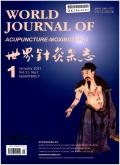针刺调节月经和促进妊娠对薄子宫内膜接受性的影响:一项实用的随机对照探索性研究
IF 1.3
4区 医学
Q4 INTEGRATIVE & COMPLEMENTARY MEDICINE
引用次数: 0
摘要
本研究旨在探讨针灸疗法调经促孕对子宫内膜薄的临床疗效。本研究为单中心实用随机对照试验,统计人员为盲人。使用 "blockrand "软件包,根据年龄(≥35,<35)将 37 名患者随机分为干预组(19 例)和对照组(18 例)。根据患者意愿重新分配后,干预组21例,对照组16例。试验于2019年3月1日至2020年9月30日在中国中医科学院针灸医院专科门诊进行。干预措施干预组给予针灸调经促孕和小剂量丙炔诺娃(每天2毫克),对照组给予大剂量丙炔诺娃(每天4毫克)。在 B 超监测下,干预从月经第 5 天开始,直到排卵结束。干预持续三个月经周期。测量主要结果为基线与干预完成后子宫内膜厚度的变化以及干预后两组之间的差异。次要指标为子宫内膜和子宫内膜下血流量、血清雌二醇水平、月经情况和不良反应。结果(1) 两组干预完成前后各项指标的比较:干预组的子宫内膜厚度、月经评分、排卵期雌二醇(E2)水平、子宫动脉搏动指数(PI)和阻力指数(RI)、子宫动脉收缩峰值速度与舒张末期速度比值(S/D)、子宫内膜血管指数(VI)、血流指数(FI)、血管血流指数(VFI)及血容量差异有显著性(P < 0.01).在对照组中,干预前后子宫内膜厚度、月经评分和 E2 有明显变化(P <;0.05),子宫动脉 PI、RI、S/D 和子宫内膜 VI、FI、VFI 及体积无差异(P >;0.05)。与对照组相比,干预组在干预后子宫内膜厚度、月经评分、E2、子宫动脉PI、RI、S/D以及子宫内膜VI、FI、VFI和体积方面均有显著差异(P <0.01)。干预组无不良反应报告。结论针刺调经促孕联合小剂量雌激素可有效改善子宫内膜薄患者的子宫内膜接受性,可能与刺激内源性激素分泌、增加子宫内膜厚度、改善血流有关。本文章由计算机程序翻译,如有差异,请以英文原文为准。
Effects on the receptivity of thin endometrium treated with acupuncture therapy for menstruation regulation and pregnancy promotion: A pragmatic randomized controlled exploratory study
Objective
This study aimed to explore the clinical effect of acupuncture therapy for menstruation regulation and pregnancy promotion on thin endometrium in the real world.
Design
This study is a single-center pragmatic randomized controlled trial blinded to the statisticians. Using the “blockrand” software package, based on the age (≥35, <35), 37 patients were randomized into an intervention group (19 cases) and a control group (18 cases). After reassignment regarding patient preference, 21 patients were included in the intervention group and 16 in the control group.
Setting
The trial was executed in the Specialty Outpatient Clinic, Acupuncture-Moxibustion Hospital of China Academy of Chinese Medical Sciences, from March 1, 2019, to September 30, 2020.
Participants
The study included 37 patients with thin endometrium and without previous acupuncture treatment.
Intervention
The intervention group was administered acupuncture for menstruation regulation and pregnancy promotion and a small-dose of progynova (2 mg daily), while the control group was administered a large-dose of progynova (4 mg daily). Interventions started from Day 5 of menstruation until the end of ovulation under B-ultrasound monitoring. The intervention lasted for three menstrual cycles.
Measurements
Primary outcomes were changes in endometrial thickness between baseline and after intervention completion and the difference between the two groups after intervention. The secondary outcomes were endometrial and subendometrial blood flow, serum estradiol levels, menstrual conditions, and adverse reactions.
Results
(1) Comparison of each indicator before and after intervention completion in the two groups: in the intervention group, the differences were significant in endometrial thickness, menstrual score, estradiol (E2) level in ovulatory period, the pulsatility index (PI) and resistance index (RI) of uterine artery, the ratio of peak systolic velocity to end-diastolic velocity (S/D), the endometrial vascular index (VI), flow index (FI), and vascular flow index (VFI) and volume (P < 0.01). In the control group, significant changes were observed in endometrial thickness, menstrual score, and E2 before and after the intervention (P < 0.05), and no differences were observed in uterine artery PI, RI, S/D and endometrial VI, FI, VFI, and volume (P > 0.05). Compared with the control group, the intervention group showed significant differences in endometrial thickness, menstrual score, E2, uterine artery PI, RI, S/D, and endometrial VI, FI, VFI, and volume after intervention (P < 0.01). No adverse reactions were reported in the intervention group. In contrast, the control group had two cases of nausea and gastrointestinal discomfort after medication, eight cases of breast distention during medication, and one case of breast nodules enlarged by 1 cm after trial completion.
Conclusion
Acupuncture for menstrual regulation and pregnancy promotion combined with a low dose of estrogen can effectively improve endometrial receptivity in patients with thin endometrium, which may be related to stimulating endogenous hormone secretion, increasing the endometrial thickness and improving blood flow.
Trial registration
AMCTR-IPR-19000295.
求助全文
通过发布文献求助,成功后即可免费获取论文全文。
去求助
来源期刊

World Journal of Acupuncture-Moxibustion
INTEGRATIVE & COMPLEMENTARY MEDICINE-
CiteScore
1.30
自引率
28.60%
发文量
1089
审稿时长
50 days
期刊介绍:
The focus of the journal includes, but is not confined to, clinical research, summaries of clinical experiences, experimental research and clinical reports on needling techniques, moxibustion techniques, acupuncture analgesia and acupuncture anesthesia.
 求助内容:
求助内容: 应助结果提醒方式:
应助结果提醒方式:


